 |
|
Ludwig van Beethoven's Piano Sonata in f-minor, Op. 57 (the "Appassionata") is a deeply personal vehicle through which Beethoven revolutionized the solo sonata on his own instrument. In this article, we explore its remarkable, innovative structure, consider the many performance issues it presents, and then survey a half-dozen pioneering recordings and some modern recordings including efforts to invoke the sound of Beethoven's own era. Finally, we acknowledge some sources for further information.
|
|
Beethoven'�s quartets, symphonies and piano sonatas all embrace the full scope of his amazing aesthetic journey from conventional classicism to previously uncharted  realms of imagination that still challenge and inspire composers, performers and listeners alike. Yet, his piano sonatas are the most intimate of these, as Beethoven wrote them for his own instrument, and thus they preserve an aural image of the ideal he sought as a performer. Until deafness forced a change in his career, Beethoven was known as one of the finest pianists of his time - and the best improviser of all, a key skill to flex the prowess of a composer'�s imagination. As solo works, the sonatas require no colleagues to dilute the personal communication between artist and audience. Thus, when we hear a Beethoven piano sonata, we come closer to the man and the artist than with any other genre of his music. realms of imagination that still challenge and inspire composers, performers and listeners alike. Yet, his piano sonatas are the most intimate of these, as Beethoven wrote them for his own instrument, and thus they preserve an aural image of the ideal he sought as a performer. Until deafness forced a change in his career, Beethoven was known as one of the finest pianists of his time - and the best improviser of all, a key skill to flex the prowess of a composer'�s imagination. As solo works, the sonatas require no colleagues to dilute the personal communication between artist and audience. Thus, when we hear a Beethoven piano sonata, we come closer to the man and the artist than with any other genre of his music.
 Among Beethoven'�s 32 published piano sonatas, one of the most compelling and significant is # 23 in f minor, Op. 57, the so-called "Appassionata," as it was a product of the same intensely visionary creative period as the "Eroica" symphony, "Kreutzer" violin sonata and Fidelio opera, and did just as much to revolutionize its genre. According to Czerny, Beethoven considered it to be his greatest sonata prior to his massive 1819 "Hammerklavier" Sonata # 29, Op. 106. (Incidentally, the "Appassionata" name, while certainly appropriate, was conferred posthumously by a publisher.) Among Beethoven'�s 32 published piano sonatas, one of the most compelling and significant is # 23 in f minor, Op. 57, the so-called "Appassionata," as it was a product of the same intensely visionary creative period as the "Eroica" symphony, "Kreutzer" violin sonata and Fidelio opera, and did just as much to revolutionize its genre. According to Czerny, Beethoven considered it to be his greatest sonata prior to his massive 1819 "Hammerklavier" Sonata # 29, Op. 106. (Incidentally, the "Appassionata" name, while certainly appropriate, was conferred posthumously by a publisher.)
The Appassionata begins with an arpeggiated tonic chord, as did Beethoven'�s very first piano sonata, but there all resemblance to its polite predecessor stops.


The opening and second theme of the Appassionata |
Here, Beethoven doubles the theme at a two-octave gap and descends to the lowest note of his five-octave instrument before he gallops up the keyboard, gets hung up on a trill, repeats the entire phrase a half-tone higher (and thus asserts an interval that will play a key role), introduces an insistent but ominous "fate" phrase that would later dominate his Fifth Symphony, angrily descends from the top back down to the very bowels of the keyboard, and then rips the remaining shreds of his sonic fabric with sharp alternating chords that interrupt a repetition of the theme, with only half-tone fragments remaining over rapid triplet accompaniment. And that'�s just the first 20 seconds, although it effectively presents the elements and sets the stormy tone of the entire first movement. The sheer concision of the opening is astounding.
The first movement proceeds to present one of Beethoven'�s inspired innovations - to use a secondary, more lyrical theme that is more a variant of the first one than the sharply differentiated contrast used in all sonata movements up to that time. The tight resemblance of the two themes adds an extraordinary sense of unity to the thrashing changes of mood, a unity confirmed as the two themes meld at the end. That thematic unity, in turn enabled a further unique touch - omitting the exposition repeat, a standard and mandatory structural requirement of the time. The sense of unprecedented fervor is abetted by the extreme contrast of dynamics, suddenly leaping from pp to ff, and by the time signature of 12/8 marked allegro assai, which belies the initial rocking lyricism to suggest the tension and sheer drama that is to come. The end of the first movement extends the feeling of instability and constant expectation by braking to a complete halt on repetitions of the "fate" motif, plunging into a manic jumble of the opening elements, and then subsiding on the sonic extreme of that bottom f note, repeated ever more softly to linger on Beethoven'�s first use of the extremely rare dynamic indication of ppp, thus indicating that the ending was to be really hushed.
As in his Kreutzer sonata,

The theme of the andante |
Beethoven follows the unprecedented drama of the opening with a respite - a seemingly thoroughly conservative set of andante variations on a simple, restful subject, although it barely qualifies as a genuine melody. Yet, there is a clear method to Beethoven'�s seemingly random slide back into tradition - the theme ties into the first movement based on its half-step progression, the bass tail mimics the rhythm of the opening, and the variations themselves - first alternating bass and treble notes in a tight canon and then adding rapid bass and treble running accompaniments - evoke the structural elements upon which the massive structure of the first movement had been built. Unlike most variation movements, the harmonic and expressive range is severely curbed - Tovey terms it "sublime inaction" and Lionel Salter "strange tranquility." But the true brilliance of the middle movement comes at its end, as Beethoven sets us up for a huge upset of the expectations he has cunningly aroused.
The final variation is a return to the humble opening,

The startling transition to the finale |
adding only a hint of impatience by omitting the repeats of each phrase, complete with soothing harmonization, and leading to a full final d-flat major cadence. But instead of the final note toward which the entire movement has been inexorably pointing, instead we get a soft, rolled diminished seventh chord, loudly repeated, that thoroughly destroys the tonality, followed by an insistent fanfare on a repeated sour chord, which then plunges into the finale, an aggressive, moto perpetuo that renews the snarling energy of the opening, but now propelled with unrelenting drive and spiked with eruptions of sharp, nervous counter-notes. It is worth recalling how Beethoven conceived this theme. According to his friend Ferdinand Ries, Beethoven conceived the finale while they took a long walk together, during which he hummed and howled inchoate runs of notes, and then upon returning home he rushed to the keyboard and improvised for a solid hour to shape the theme. While this method would prove frustrating to later scholars trying to trace Beethoven'�s creative process, Barry Cooper observed that it was more efficient than trying to work out variants on paper, as Beethoven often did in his musical sketchbooks.
Beethoven'�s formal innovations are not yet over - for the first time in any sonata movement, not only does he omit the exposition repeat but insists on a repeat of the entire development and recapitulation sections, as if to proclaim to the world that henceforth it is the most creative and free-ranging segment of the time-honored form with which he will concern himself.


The themes of the finale and its coda |
Rudolph Beti feels that this novel structure was compelled by a need dictated by the overall architecture, which demands that any significant element be repeated in the course of a composition; here, Beethoven deferred the first appearance of the second theme of the finale until the development section, which thus had to be repeated. However, that theory ignores one further surprise - Beethoven'�s introduction of yet another wholly new theme in the last half-minute. Indeed, after this thoroughly exhausting movement, Beethoven makes ever crueler demands on would-be intrepid performers with a coda that pounds away with isolated syncopated sfortzando phrases over a manically rapid running accompaniment at a presto pace, winding up again with f-minor triads in the depth of the keyboard, thus finally reaffirming the tonality of the outset and at last giving us the full final cadence denied us in the prior movements.
Beethoven dedicated nearly all his compositions to noble patrons, but the Appassionata may have been special in that regard. Its actual dedication is to Count Franz von Brunswick. Eric Blom notes that Beethoven was in love at the time with both of the Count'�s two sisters - Therese von Brunswick, a placid maiden whose appeal was entirely spiritual, and Josephine von Deym, a spirited widow whose attraction was mostly physical. Blom speculates that the raging mood of the Appassionata reflects the duality of these inclinations that plagued Beethoven, and that the dedication to their brother was a discreet way of honoring his feelings. (When asked to explain the significance of his sonata, Beethoven reportedly advised: "Read Shakespeare'�s Tempest," but no commentator has deciphered what he meant - indeed, while we tend to read a world of significance into every utterance of a genius, perhaps it was just off-hand pique.)
 Beethoven may have loved the piano as the means to express his most personal musical thoughts, but he had far lesser feelings toward the instruments themselves. Beethoven may have loved the piano as the means to express his most personal musical thoughts, but he had far lesser feelings toward the instruments themselves.
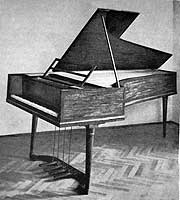
Beethoven's Erard piano |
The reason is apparent from the mere appearance of the spindly piano on which he wrote the Appassionata, as it could not possibly have produced the impassioned expression that pervades that work. Indeed, as early as 1796, Beethoven disparaged the pianos of his time as so undeveloped that "often one thinks that one is merely listening to a harp." It is believed that Beethoven never bought a piano, although he owned or borrowed over a dozen at various times. Rather, manufacturers offered him gifts or loans of their latest models for the prestige of association with the great pianist-composer. As recounted by William S. Newman, Beethoven "needed an instrument capable of withstanding his animal energies" and was never satisfied with any piano. He claimed to prefer Viennese models with their relatively light action and clear tones, although he later gravitated toward the English Broadwood with its heavier construction and wider dynamic range, which he was given in 1818 and which he may have had in mind for his final four sonatas. Shortly before writing the Appassionata, he had accepted the gift of an Erard piano from its Parisian manufacturer, but although he kept it until 1825 he wrote in 1810 that it was "quite useless."

Van Cliburn at a modern concert grand |
Newman asserts that Beethoven was frustrated by the five-octave range of his instruments and had to make some thematic compromises to fit his conceptions within their span. With the Appassionata, Beethoven clearly hit the bottom of the keyboard of the time, and his many repeated FF notes suggests that he might have delved even lower had that been feasible. Indeed, it is possible that the key of f minor was chosen in order to exploit the lowest fundamental note possible on Beethoven'�s piano. (As Denis Matthews notes, Beethoven'�s Sonata # 21, Op. 53 ( "Waldstein"), written at the same time, exploits the upper regions of the keyboard, and thus complements the Appassionata.)
How did Beethoven play his own Appassionata? There seems to be no direct evidence, and, indeed, the work was never performed in public during Beethoven'�s lifetime - hardly surprising, as an early critic had found it "incomprehensibly abrupt and dark - much of it is enormously difficult without there being some exceptional beauty to compensate for it." What little we can glean from contemporaneous written descriptions is confusingly abstract and often contradictory. Thus, Beethoven's pupil Carl Czerny stated: "His bearing while performing was ideally restful, noble and beautiful, without the slightest grimace." Others tended to admire his legato effects and exquisitely even scalar runs. Yet, Czerny also stated: "His playing, like his compositions, was far ahead of his time - The pianofortes of the period could not endure his gigantic style of performance."  Beethoven'�s first biographer, Anton Schindler, said: "His playing was free of all constraint with respect to the beat, for the spirit of his music required freedom." Ernst Pauer, editor of an early edition of Beethoven'�s piano works, added: "He was not particular in polishing and refining his performances." Ferdinand Ries, who was a piano student of Beethoven from 1801-4, seems to take a middle course, recalling that during this phase of Beethoven'�s career: "Generally he played his compositions very impetuously but for the most part stayed strictly in time, only infrequently pushing the tempo a little. Occasionally he would retard during a crescendo which created a very beautiful and most remarkable effect." Schindler clarifies that this seeming anomaly arose from stressing the rhythm strictly while treating the melody more expressively (a foretaste of the rubato style later to be perfected by Chopin). The result: "His playing thus acquired a highly personal character, very different from the even, flat performances that never rise to tonal eloquence." Harold Schonberg suggests that as a composer Beethoven had little concern for keyboard mechanics; rather, he replaced taste with expression by playing with unprecedented power, personality and emotional appeal. Schonberg further notes that Beethoven'�s teachers were not professional pianists and so he was largely self-taught; as a result his piano works were not pianistic in the sense of fitting well on the keyboard, and to Beethoven the idea was always far more important than the practical consideration of its execution. Beethoven'�s first biographer, Anton Schindler, said: "His playing was free of all constraint with respect to the beat, for the spirit of his music required freedom." Ernst Pauer, editor of an early edition of Beethoven'�s piano works, added: "He was not particular in polishing and refining his performances." Ferdinand Ries, who was a piano student of Beethoven from 1801-4, seems to take a middle course, recalling that during this phase of Beethoven'�s career: "Generally he played his compositions very impetuously but for the most part stayed strictly in time, only infrequently pushing the tempo a little. Occasionally he would retard during a crescendo which created a very beautiful and most remarkable effect." Schindler clarifies that this seeming anomaly arose from stressing the rhythm strictly while treating the melody more expressively (a foretaste of the rubato style later to be perfected by Chopin). The result: "His playing thus acquired a highly personal character, very different from the even, flat performances that never rise to tonal eloquence." Harold Schonberg suggests that as a composer Beethoven had little concern for keyboard mechanics; rather, he replaced taste with expression by playing with unprecedented power, personality and emotional appeal. Schonberg further notes that Beethoven'�s teachers were not professional pianists and so he was largely self-taught; as a result his piano works were not pianistic in the sense of fitting well on the keyboard, and to Beethoven the idea was always far more important than the practical consideration of its execution.
A further challenge to modern performance lies in Czerny'�s suggestion that the scores themselves are only an incomplete indication of Beethoven'�s realization of his works, as he never had the time or patience to practice, so the result of playing his compositions depended upon "accident or his mood [plus he] made much more frequent use of pedals than is indicated in his works."  (Yet, Ries wrote that Beethoven "seldom introduced notes or ornaments not set down in the composition.") Newman points out that even the autograph scores present vast difficulties to interpreters, since Beethoven used signs for articulation - the primary means by which a pianist creates expression from an instrument having no means to vary timbre but only control over duration and intensity - such as irregular slurs and beams are used inconsistently and even illogically, and several different staccato and accent signs can look confusingly similar in Beethoven'�s slapdash penmanship. (Yet, Ries wrote that Beethoven "seldom introduced notes or ornaments not set down in the composition.") Newman points out that even the autograph scores present vast difficulties to interpreters, since Beethoven used signs for articulation - the primary means by which a pianist creates expression from an instrument having no means to vary timbre but only control over duration and intensity - such as irregular slurs and beams are used inconsistently and even illogically, and several different staccato and accent signs can look confusingly similar in Beethoven'�s slapdash penmanship.
In light of all this, perhaps the very notion of defining a "Beethoven style" is misguided. Beethoven himself wrote in 1826: "We can have no further tempi ordinari since one must respond to the call of unconstrained genius."  Pauer recalled that Beethoven chided other virtuosi of his time as "gymnasts" and expressed the opinion that "the increasing mechanism of piano playing would in the end destroy all truth of expression in music."
Thus, perhaps the only unequivocal view was expressed by Czerny: "Beethoven'�s compositions must be played differently from - anyone else'�s. It is not easy to express this difference in words." Pauer recalled that Beethoven chided other virtuosi of his time as "gymnasts" and expressed the opinion that "the increasing mechanism of piano playing would in the end destroy all truth of expression in music."
Thus, perhaps the only unequivocal view was expressed by Czerny: "Beethoven'�s compositions must be played differently from - anyone else'�s. It is not easy to express this difference in words."
Yet, despite the lack of definitive or even reliable guidance, performers must try to evoke the composer'�s intention and feeling when approaching Beethoven'�s piano sonatas. One of the most touching, but perhaps revealing, descriptions of Beethoven'�s playing is quoted by Schonberg from Sir John Russell toward the very end of the composer'�s life, when he was stone deaf and his "playing" had become an abstraction - yet perhaps this is the most important description we have, as it portrays Beethoven'�s purest ideal as a performer, at last unfettered from the constraints of the actual instruments of his time:
The moment he is seated at the piano he is evidently unconscious that there is anything else in existence. ... The muscles of his face swell and its veins stand out; the wild eye rolls doubly wild; the mouth quivers; and Beethoven looks like a wizard overpowered by the demons he has called up. ... When playing softly, he does not bring out a single note. He hears it himself in his "mind'�s ear," while his eye, and the almost imperceptible motion of his fingers, shows that he is following out the strain in his own soul through all its dying gradations.
That strikes me as the most meaningful guide to a great performance of the Appassionata.
 Of the several dozen Appassionatas on record that I'�ve heard, the oldest ones tend to exemplify the sheer emotion that Beethoven poured into this music and the sense of freedom that he reportedly brought to his own performance style. Of the several dozen Appassionatas on record that I'�ve heard, the oldest ones tend to exemplify the sheer emotion that Beethoven poured into this music and the sense of freedom that he reportedly brought to his own performance style.
Frederic Lamond (1927; HMV 78s, Biddulph CD) - Scottish born, Lamond (1868 - 1948) was considered the greatest interpreter of Beethoven in his time. Lamond revered Beethoven, calling him "my god - the creed of my life - my one and all."   While it may be stretching the point to find a special affinity simply because his teacher, Liszt, was a pupil of Czerny, who was Beethoven'�s own student, Lamond'�s style is fully convincing, and his early electrical performance of the Appassionata (a remake of an earlier 1923 acoustical set) is, well, truly electrifying. He advised his students to "try to play in some way of your own, as if you were telling the world for the first time of the wonder of Beethoven," and, indeed, his playing here boasts a remarkable freshness and spontaneity that is never encountered nowadays. In part this derives from Lamond'�s bold tempos - while the overall 17-minute timing is somewhat deceptive, as he omits the third-movement repeat to fit the work onto four 78 rpm sides, his Appassionata still is the swiftest on record, barely pausing to add enormous color to the andante variations before plunging into a torrential finale, with the coda taken at a breakneck speed. His pulse is constantly alive, but never in a way that suggests ego or caprice; rather, he seems possessed by a creative impulse that injects infectious enthusiasm into every phrase. We will never know just how Beethoven played his Appassionata, but Lamond'�s ardor brings us closer, not only in time but in spirit, than any other pianist on record. While it may be stretching the point to find a special affinity simply because his teacher, Liszt, was a pupil of Czerny, who was Beethoven'�s own student, Lamond'�s style is fully convincing, and his early electrical performance of the Appassionata (a remake of an earlier 1923 acoustical set) is, well, truly electrifying. He advised his students to "try to play in some way of your own, as if you were telling the world for the first time of the wonder of Beethoven," and, indeed, his playing here boasts a remarkable freshness and spontaneity that is never encountered nowadays. In part this derives from Lamond'�s bold tempos - while the overall 17-minute timing is somewhat deceptive, as he omits the third-movement repeat to fit the work onto four 78 rpm sides, his Appassionata still is the swiftest on record, barely pausing to add enormous color to the andante variations before plunging into a torrential finale, with the coda taken at a breakneck speed. His pulse is constantly alive, but never in a way that suggests ego or caprice; rather, he seems possessed by a creative impulse that injects infectious enthusiasm into every phrase. We will never know just how Beethoven played his Appassionata, but Lamond'�s ardor brings us closer, not only in time but in spirit, than any other pianist on record.
Harold Bauer (1926; VAI CD) - Based on his background as a violinist until he switched to the piano at the very advanced age (for a virtuoso) of 20, one would expect Bauer (1873 - 1951) to have brought to his piano playing a violinist'�s tendency for smooth phrasing, finely graded dynamics and soulful distention of rhythm, qualities that are readily apparent in Bauer'�s delicate Liszt and much of his other recorded repertoire. Thus, Bauer'�s Appassionata comes as quite a surprise, nearly matching Lamond for speed and pressing forward with a constant velocity that impresses for its steadfast accuracy while eschewing most rhetorical flourishes. His only other Beethoven recording, of the "Moonlight" Sonata, is more expressive, mining considerable reflection in the first movement despite a brisk pace of a mere 11 minutes.
Artur Schnabel (1933; Beethoven Society 78s, Naxos CDs) - Dubbed by Schonberg "the Man Who Invented Beethoven" in homage to the authority of his interpretations, Schnabel (1882 - 1951) was the first pianist to record a complete cycle of the Beethoven piano sonatas and major sets of variations (at first issued only in a limited edition for private subscription in 15 volumes comprising 102 (!) records, as their commercial appeal was in doubt). 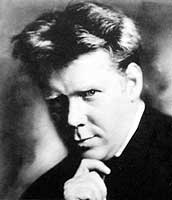 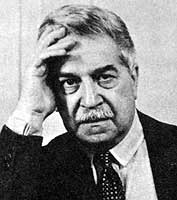 Yet Schnabel remained humble, devoting himself to playing only works that he considered better than they could be performed. A composer of atonal music, Schnabel was known for the intellectual logic and rigor of his performances of Beethoven, as well as Mozart, Schubert and Brahms, yet, like Lamond'�s, they exhibit a freedom imbued with integrity in the service of art. Despite technical lapses, his Appassionata is compelling for its extraordinary sense of architecture. Despite the misgivings of the original producers, Schnabel'�s Beethoven sonata cycle has been constantly reissued to satisfy demand, most recently in superlative CD transfers by Mark Obert-Thorn on Naxos. Yet Schnabel remained humble, devoting himself to playing only works that he considered better than they could be performed. A composer of atonal music, Schnabel was known for the intellectual logic and rigor of his performances of Beethoven, as well as Mozart, Schubert and Brahms, yet, like Lamond'�s, they exhibit a freedom imbued with integrity in the service of art. Despite technical lapses, his Appassionata is compelling for its extraordinary sense of architecture. Despite the misgivings of the original producers, Schnabel'�s Beethoven sonata cycle has been constantly reissued to satisfy demand, most recently in superlative CD transfers by Mark Obert-Thorn on Naxos.
Edwin Fischer (1935, Philips CD) - With Fischer (1886 - 1960) we approach a relatively straight-forward rhythm that paves the way toward our modern expectations - hardly surprising in light of his role as a Bach pioneer (having recorded the first integral set of the Well-Tempered Clavier). Fischer also clearly emphasizes the lyrical elements at the expense of power, leading to a rather inert finale that depends upon cumulative driving force for its impact. Yet his poetic approach is studded with occasional touches that produce an unexpected and striking effect - an especially emphatic cadence that suggests victory, a pause that implies relief, resounding bass that creates a sense of ominous expectation, accentuating alternate notes within a sequence of repetition to create a fascinating syncopation. Each of these conjure a realm of emotional overtones that make the entire work more accessible, even for those already familiar with it. Other touches are less welcome, though, as Fischer'�s execution is haphazard, with a disturbing number of wrong or missed notes and mangled runs. Even so, with Fischer we hear the confluence of two strong personalities - the composer'�s and the performer'�s - which is the very essence of this recreative art.
Rudolph Serkin (1936; Philips CD) - With Serkin (1903 - 1991) we arrive at what most would consider a genuinely modern performance of the Appassionata. Perhaps the most reliable proof is that his recording is so hard to characterize. Serkin was hailed as one of the greatest Beethoven pianists of his time, but few venture any attempt to explain why. His playing is note-perfect and clean - the result of scrupulous study, long practice and intense concentration - without any attempt to supplant the music with his own personality.  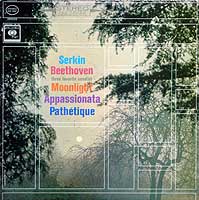 The fact that the result emerges as compelling rather than boring is a tribute to the wisdom of placing the entire spotlight on the composer rather than upon himself, as if to say that Beethoven knew exactly what he was doing and any deviation from the clear indications of the score can only detract from the perfection of the masterpieces he produced. Whether Beethoven himself would have agreed is an intriguing question - while he reportedly took considerable liberties with his own music, it is a far different question as to how he expected others to play it. Indeed, his was an age before the compulsion to interpret arose, and the care with which he specified dynamics and accents in his scores suggests the importance he attached to giving clear directives to other performers. Serkin'�s 1963 stereo remake (Columbia LP, Sony CD), coupled with the Pathetique and Moonlight sonatas, was a huge best-seller and reflected the more assertive style of his full maturity. The fact that the result emerges as compelling rather than boring is a tribute to the wisdom of placing the entire spotlight on the composer rather than upon himself, as if to say that Beethoven knew exactly what he was doing and any deviation from the clear indications of the score can only detract from the perfection of the masterpieces he produced. Whether Beethoven himself would have agreed is an intriguing question - while he reportedly took considerable liberties with his own music, it is a far different question as to how he expected others to play it. Indeed, his was an age before the compulsion to interpret arose, and the care with which he specified dynamics and accents in his scores suggests the importance he attached to giving clear directives to other performers. Serkin'�s 1963 stereo remake (Columbia LP, Sony CD), coupled with the Pathetique and Moonlight sonatas, was a huge best-seller and reflected the more assertive style of his full maturity.
Walter Gieseking (1939; Philips CD) - Gieseking (1895 - 1956) was known as a specialist in the French impressionists and Mozart. (He recorded the first complete set of the Mozart piano sonatas with an even-handedness that chafed against the accepted wisdom of the time that relegated Mozart to rococo insignificance.) His exquisitely light touch, infinite grading of dynamics and sense of subtle coloration produced an Appassionata that makes us hang on every note, especially in the andante, where he transforms the usual break between the boisterous outer movements into a succession of heartfelt moods that adds a sense of logic to the transition to the finale, which in his hands is more of an evolution than an abrupt breach. His finale bristles with virtuoso fireworks, played nearly perfectly at a thrilling tempo but never with any sense that he is on the verge of losing control. While his approach may not seem idiomatic, it succeeds in presenting the Appassionata in a wholly new light that proves its universality. Gieseking'�s EMI LP remake from the early 1950s is nearly as good, but lacks some of the extreme delicacy of his earlier version.
 While the designation of the above recordings as historically significant is a matter of chronological fact, the selection of subsequent ones becomes far more subjective. The substitution of LPs and then CDs for 78s also led to common pairings of the Appassionata with other favorite sonatas, especially the Waldstein (which also fit comfortably on a single LP side), or, most frequently, the so-called Pathetique (# 8 in c minor) and Moonlight (# 14 in c-sharp minor) (which generally shared a single side), or occasionally Les Adieux (# 26 in E-flat). While the designation of the above recordings as historically significant is a matter of chronological fact, the selection of subsequent ones becomes far more subjective. The substitution of LPs and then CDs for 78s also led to common pairings of the Appassionata with other favorite sonatas, especially the Waldstein (which also fit comfortably on a single LP side), or, most frequently, the so-called Pathetique (# 8 in c minor) and Moonlight (# 14 in c-sharp minor) (which generally shared a single side), or occasionally Les Adieux (# 26 in E-flat).
Arthur Rubinstein (1945, 1954, 1963 and 1975 (live), RCA) - Although Rubinstein (1887 - 1982) is often hailed as a quintessentially romantic pianist, I tend to agree with Harvey Sachs (in his Arthur Rubinstein - A Life, Grove Press, 1995) that his approach to Beethoven, at least in the studio, was direct, with no posturing, monumentalizing or rhetoric - which pretty much characterizes his three studio Appassionatas. 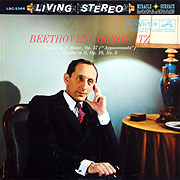  Yet there is another far more remarkable side to Rubinstein that is far less documented - an electric vigor that energized his concerts, of which only a handful have been released. The last is a 1975 recital that he gave at the very end of his professional life. Critics have uniformly savaged it - Sachs calls it "banging, disjointed and sloppy" - all true, and yet although Rubinstein was 88, nearly blind, in precarious health, and with diminished energy (he skips the last movement repeat), he plays his heart out and manages to conjure a degree of abandon and risk that transcends his comparatively sterile studio forays. Forget the wrong notes, stuttering rhythms, unbalanced voices and jagged phrasing - and there are loads of them - as well as the thin, distorted and compressed sound. This is an intensely moving document that - despite its many flaws - indeed, perhaps because of them - throbs with the composer'�s humanity and overwhelms with its sense of soulful communication. Yet there is another far more remarkable side to Rubinstein that is far less documented - an electric vigor that energized his concerts, of which only a handful have been released. The last is a 1975 recital that he gave at the very end of his professional life. Critics have uniformly savaged it - Sachs calls it "banging, disjointed and sloppy" - all true, and yet although Rubinstein was 88, nearly blind, in precarious health, and with diminished energy (he skips the last movement repeat), he plays his heart out and manages to conjure a degree of abandon and risk that transcends his comparatively sterile studio forays. Forget the wrong notes, stuttering rhythms, unbalanced voices and jagged phrasing - and there are loads of them - as well as the thin, distorted and compressed sound. This is an intensely moving document that - despite its many flaws - indeed, perhaps because of them - throbs with the composer'�s humanity and overwhelms with its sense of soulful communication.
Vladimir Horowitz (1960, RCA LP; 1972, Columbia LP, Sony CD) - Horowitz (1904 - 1989) represented the virtuoso approach to Beethoven'�s piano music, playing only a handful of the most popular sonatas with breathtakingly precise technique. In the notes to his RCA LP, Horowitz asserted that he sought to deliberately strip the first movement of lyricism "because for me it is appassionata from first to last," and that he had no wish to disturb the rage or hold the passion in check. Yet, while he certainly avoids any slide into sentimentality, his phrasing and tempos are sufficiently plastic to differentiate the constantly shifting moods inherent in the music itself. Horowitz also boasted of taking the finale at a moderate pace to stress the ma non troppo qualification of the allegro tempo indication, but the sheer splendor of his execution and sharpness of his attacks provides ample thrills without reckless velocity. Above all, the famous "Horowitz sound" of phenomenally controlled power and razor-sharp attacks creates a magnificent realization. Of his two nearly identical recordings, his Columbia remake has richer sound that adds weight to the overall impact.
Wilhelm Backhaus (1960, London LP) - 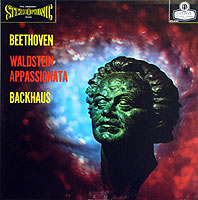 While conceding his reputation as a Beethoven specialist, Schonberg views Backhaus (1884 - 1969) as an exemplar of the "German school" of piano playing, which he characterizes as "one of scrupulous musicianship, severity, strength rather than charm, solidity rather than sensuosity, intellect rather than instinct, sobriety rather than brilliance. It is a school that stresses planning and leaves nothing to chance." He singles Backhaus out for monumental solidity and impassivity. To the extent that this suggests reliable integrity that lets the music speak for itself, it'�s an accurate and fair characterization of his latter performances, including this Appassionata, the product of a fully mature artist, which grips with its rich patina and unfolds with inexorable logic (although Backhaus'�s earlier Beethoven sonata recordings tended to be considerably more expressive). While conceding his reputation as a Beethoven specialist, Schonberg views Backhaus (1884 - 1969) as an exemplar of the "German school" of piano playing, which he characterizes as "one of scrupulous musicianship, severity, strength rather than charm, solidity rather than sensuosity, intellect rather than instinct, sobriety rather than brilliance. It is a school that stresses planning and leaves nothing to chance." He singles Backhaus out for monumental solidity and impassivity. To the extent that this suggests reliable integrity that lets the music speak for itself, it'�s an accurate and fair characterization of his latter performances, including this Appassionata, the product of a fully mature artist, which grips with its rich patina and unfolds with inexorable logic (although Backhaus'�s earlier Beethoven sonata recordings tended to be considerably more expressive).
Wilhelm Kempff (1964, DG) - Kempff (1895 - 1991) was the other great Beethoven player among German pianists of his time, and was the first to record the complete cycle twice - on LP for Deutche Grammophon, first in the early 1950s and then in stereo a decade later. His Appassionata is far lighter than Backhaus'�s, emphasizing lyricism, color and clarity rather than the philosophical weight that more often is thought to typify the German approach. His moderate tempos further abet an overall aura of lightness that undercuts the gravity of the work, not necessarily to its advantage.
Sviatoslav Richter (November 1, 1959 at Prague, Music and Arts CD; June 9, 1960 at Moscow, Melodiya CD; October 19, 1960 at Carnegie Hall, Columbia LP; November 29-30, 1960 at a New York studio, Philips CD) - Richter (1915 - 1997) gave the West its first taste of Beethoven played with unabashed Russian passion when he made his American debut in a series of five recitals at Carnegie Hall in October 1960.   The first program consisted of five Beethoven sonatas, concluding with the Appassionata (which, he insisted, could never be followed by any other work). Hyped to the hilt based on reports of his prowess in Russia and Eastern Europe, Richter was nervous and overmedicated and the result is somewhat tentative and a relative letdown (including a disastrous conclusion) - but only when compared to his other three authorized releases, all of which fell within a single year of his long career and feature seething tension, colossal dynamics, massive power and explosive climaxes. The first program consisted of five Beethoven sonatas, concluding with the Appassionata (which, he insisted, could never be followed by any other work). Hyped to the hilt based on reports of his prowess in Russia and Eastern Europe, Richter was nervous and overmedicated and the result is somewhat tentative and a relative letdown (including a disastrous conclusion) - but only when compared to his other three authorized releases, all of which fell within a single year of his long career and feature seething tension, colossal dynamics, massive power and explosive climaxes.
Emil Gilels (1973; DG CD) - With Gilels (1916 - 1985), we have the other side of the Russian coin. Reputed for their penchant for romanticism, most of the non-expatriate Soviet pianists tend more toward the throttling of massive technique to achieve control and subtlety in lyric passages rather than the startling overt power of Richter or Horowitz. Gilels'� Appassionata is exquisitely tender, with finely-graded softness and subtle shading of rhythm, all infused with steady tension and abetted by a wonderfully rich recording. By dwelling at the bottom of the dynamic range, he also suggests an air of constant expectation that a louder performance would dispel. When the outbursts do come they are smoothly integrated into the entire fabric rather than a disruption. Gilels'� unhurried tempo (25Ω minutes) is just leisurely enough to allow all of the detail to unfold and register, but without losing a sense of momentum. The inherent energy of his finale is constantly held in abeyance, threatening to emerge at every turn, yet creating an overall aura of lyrical expression that adds an unusual patina of grace to a piece that often impresses by its relentless and even brutal onrushing strength.
Glenn Gould (1974; Columbia LP, Sony CD) -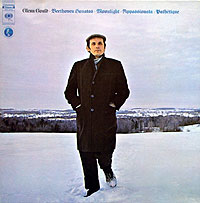 By far the most bizarre - indeed, perverse - recording of the Appassionata is by Glenn Gould (1932 - 1982). Running nearly 32 minutes without the finale repeat - just about double Lamond'�s and Bauer'�s pace - Gould set about to drain the work of any hint of its inherent emotion and amply succeeded. Indeed, as the LP cover photo suggests, his reading is downright frigid. In his liner notes, Gould scorns the work as a failure, born of "egoistic pomposity" that, he felt, afflicted most of Beethoven'�s middle-period works: "His conceit at this period was to create mammoth structures from material that, in lesser hands, would scarcely have afforded a good sixteen-bar intro. - The development - is disorganized, offering sequential stereotypes - . No one had ever before composed with so belligerent an attitude - ." Gould goes on to accuse Beethoven of vapid heroic gestures to cull "frenzied approval from the balcony" and ranks the Appassionata just above Beethoven'�s trashy Wellington'�s Victory pastiche, written for a mechanical orchestra for quick cash. Clearly of a minority opinion, Gould proceeds to mechanically plod through the work at a glacial pace ostensibly in order to search for and elucidate its structure. Curiously, though, his bracing finale, although abbreviated, is taken at a reasonable speed, beautifully articulated and is rather effective. That alone suggests that Gould didn'�t really hate the Appassionata as much as his vituperative diatribe suggests, but rather refused to meet it on its own terms. Gould'�s record is worth hearing once, if only to better appreciate nearly every other interpretation. (Its LP companions were a clean and lucid Pathetique and, as if to compensate for the Appassionata, a breathless Moonlight shorn of its customary dreamy repose.) By far the most bizarre - indeed, perverse - recording of the Appassionata is by Glenn Gould (1932 - 1982). Running nearly 32 minutes without the finale repeat - just about double Lamond'�s and Bauer'�s pace - Gould set about to drain the work of any hint of its inherent emotion and amply succeeded. Indeed, as the LP cover photo suggests, his reading is downright frigid. In his liner notes, Gould scorns the work as a failure, born of "egoistic pomposity" that, he felt, afflicted most of Beethoven'�s middle-period works: "His conceit at this period was to create mammoth structures from material that, in lesser hands, would scarcely have afforded a good sixteen-bar intro. - The development - is disorganized, offering sequential stereotypes - . No one had ever before composed with so belligerent an attitude - ." Gould goes on to accuse Beethoven of vapid heroic gestures to cull "frenzied approval from the balcony" and ranks the Appassionata just above Beethoven'�s trashy Wellington'�s Victory pastiche, written for a mechanical orchestra for quick cash. Clearly of a minority opinion, Gould proceeds to mechanically plod through the work at a glacial pace ostensibly in order to search for and elucidate its structure. Curiously, though, his bracing finale, although abbreviated, is taken at a reasonable speed, beautifully articulated and is rather effective. That alone suggests that Gould didn'�t really hate the Appassionata as much as his vituperative diatribe suggests, but rather refused to meet it on its own terms. Gould'�s record is worth hearing once, if only to better appreciate nearly every other interpretation. (Its LP companions were a clean and lucid Pathetique and, as if to compensate for the Appassionata, a breathless Moonlight shorn of its customary dreamy repose.)
... and some others - Among the many other Appassionatas I've heard, Daniel Barenboim (1985, EMI) takes a deeply heartfelt, impassioned approach with sharp chords, crisp articulation, melodramatic pauses and tempo distensions, all at a patient pace (24 minutes without the repeat) that allows extraordinarily tender passages to emerge. Emanuel Ax (1979, RCA) brings an appropriate and welcome sense of youthful discovery to the work. On the basis of his thoughtful recording, Sascha Gorodnitzki (c. 1955, Capitol LP) deserved far more recognition. Lazar Berman (1976, Columbia) and Vladimir Ashkenazy (1973, London) apply their huge, commanding, outgoing techniques for fine, if not especially distinctive, renditions. Claudio Arrau (1967, Philips) and Alfred Brendel (19xx, Philips) are a bit too dry and objective for me in this passionate music. Van Cliburn (1972, RCA) seems rather perfunctory.
Fortepiano recordings - All of the above recordings were made on modern concert grand pianos. Also intriguing are any of several Appassionata recordings on fortepianos, including those by Melvin Tan (EMI), Anthony Newman (Newport), Paul Badura-Skoda (Astree), John Khouri (Music and Arts) and Lambert Orkis (Bridge) - the last featuring Appassionatas on each of three period instruments. Regardless of whether Beethoven wrote his keyboard works for idealized instruments he could only imagine, the fact remains that these were the only models of instruments that he had available for his own use and on which he heard his works performed. Compared to the sound image to which we are accustomed, they have a distinctive woody timbre and a far richer display of overtones at the expense of vibrant bass and sustained tones. Their sheer delicacy and restricted dynamics add a mortal quality to the Appassionata, as the instruments are pushed well beyond their design and natural emotional range and even seem to balk at the composer'�s demands. Above all else, hearing the Appassionata on Beethoven'�s own instruments emphasizes the extraordinary gap between his creative impulses and the limitations of his time, and fosters renewed appreciation for the unbounded genius of his bold vision.
 Among the valuable sources for this article and for further reading are:
Among the valuable sources for this article and for further reading are:
- Eric Blom - Extensive and enthralling analyses originally written for the Beethoven Society sets of Schnabel 78s, reprinted for the subsequent Angel and Seraphim LP reissues, and also available in book form as Beethoven'�s Pianoforte Sonatas Discussed (Dutton, 1938).
- William S. Newman: Beethoven on Beethoven - Playing his Piano Music His Way (Norton, 1988) - a wonderful guide to how Beethoven'�s scores and the properties of the instruments themselves influenced his compositions and performance style.
- Harold Schonberg: The Great Pianists (Simon & Schuster, 1963) - an extraordinarily readible survey of pianism and its most famous practitioners.
- The liner notes to the various LPs and CDs cited throughout this article.

Copyright 2009 by Peter Gutmann
|
